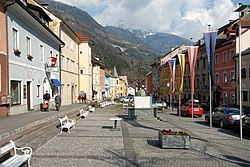Obervellach
| Obervellach | ||
|---|---|---|

Main square
|
||
|
||
| Location within Austria | ||
| Coordinates: 46°55′N 13°12′E / 46.917°N 13.200°ECoordinates: 46°55′N 13°12′E / 46.917°N 13.200°E | ||
| Country | Austria | |
| State | Carinthia | |
| District | Spittal an der Drau | |
| Government | ||
| • Mayor | Anita Gössnitzer (ÖVP) | |
| Area | ||
| • Total | 104.41 km2 (40.31 sq mi) | |
| Elevation | 632 m (2,073 ft) | |
| Population (1 January 2016) | ||
| • Total | 2,284 | |
| • Density | 22/km2 (57/sq mi) | |
| Time zone | CET (UTC+1) | |
| • Summer (DST) | CEST (UTC+2) | |
| Postal code | 9821 | |
| Area code | 04782 | |
| Website | www.obervellach.at | |
Obervellach (Slovene: Zgornja Bela) is a market town in the district of Spittal an der Drau, in the Austrian state of Carinthia.
The settlement is situated in the valley of the Möll river, on the southern slope of the High Tauern mountain range, where the Tauern Railway line descends from neighbouring Mallnitz and the southern Tauern Tunnel portal. The municipal area comprises the cadastral communities of Obervellach proper, Pfaffenberg, Lassach, and Söbriach.
The settlement of Velach was first mentioned in a 10th-century deed issued by the Bishop Abraham of Freising (d. 993/94), a Bavarian missionary among the East Alpine Slavs in the Duchy of Carinthia (former Carantania), known for the Slovene Freising manuscripts. The name is probably derived from Slavic bela ("white"). The local church was mentioned as 'Freising basilica' in 1072, it later became the seat of a deanery of the Salzburg archbishops.
The traditional gold and silver mining area from the 12th century onwards was a possession of the comital House of Gorizia (Görz); in 1164 their ministeriales took their residence at Falkenstein Castle high above the valley. The Counts of Gorizia also held nearby Groppenstein Castle, first mentioned in 1254. Obervellach market rights were attested in 1256. After an armed conflict over the inheritance of late Count Ulrich II of Celje, in which the Count Leonhard of Gorizia and his brother John II were defeated by the forces of Emperor Frederick III, the area of Obervellach in 1460 finally was incorporated into the Inner Austrian possessions of the ruling House of Habsburg.
...
Wikipedia


